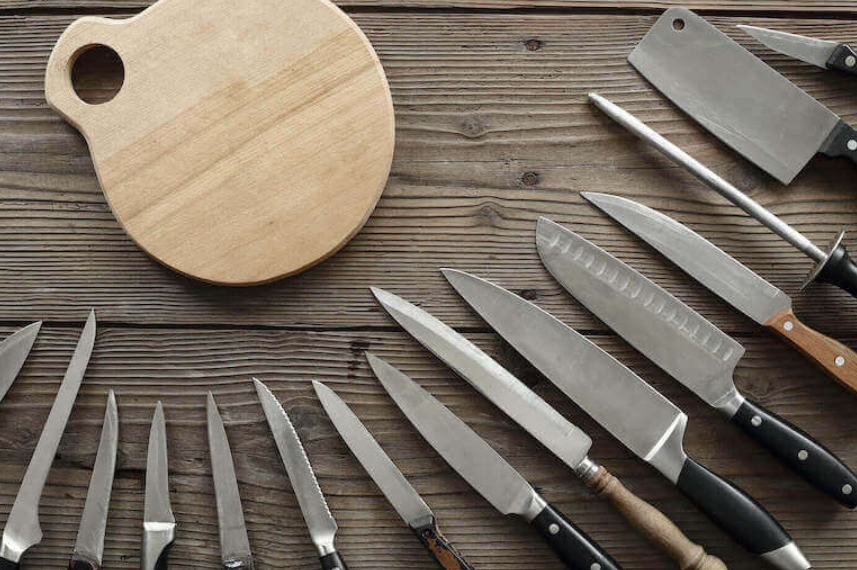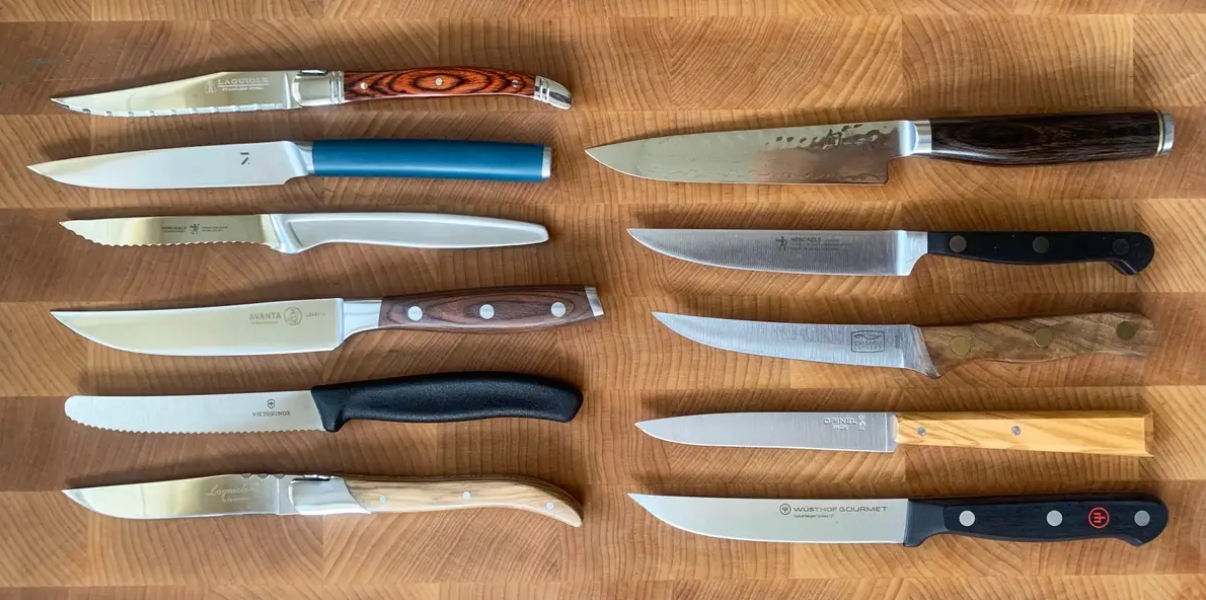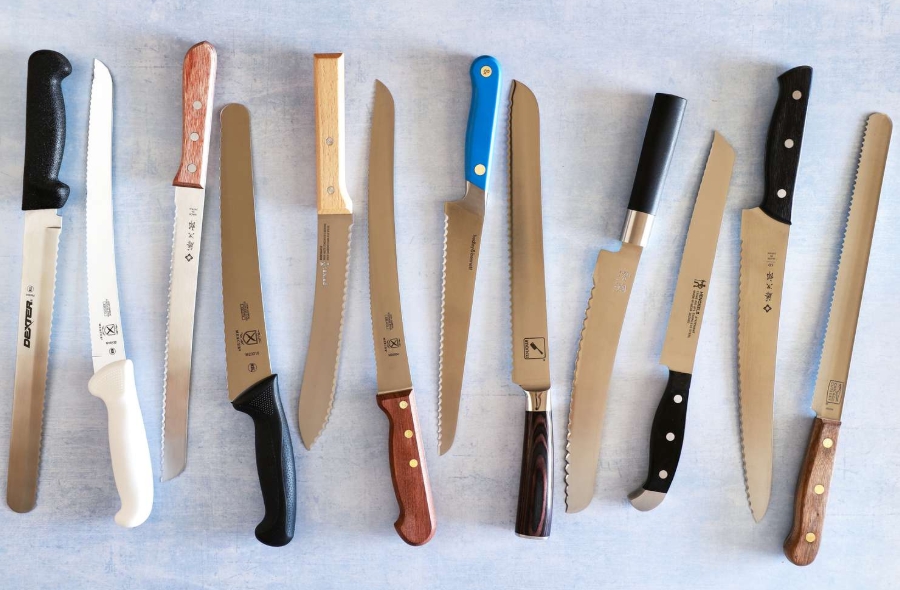

Views: 222 Author: Ella Publish Time: 2025-04-22 Origin: Site








Content Menu
● How Forged and Stamped Knives Are Made
>> Forged Knives: The Art of Strength
>> Stamped Knives: Precision and Efficiency
● Key Differences: Forged vs. Stamped Knives
>> Forged Knives: Built for Power and Precision
>> Stamped Knives: Lightweight and Versatile
>> Forged vs. Stamped Knives Explained
>> How Kitchen Knives Are Made
● How to Choose the Right Knife for You
● FAQ: Top 5 Questions About Forged and Stamped Knives
>> 1. Which knife stays sharp longer, forged or stamped?
>> 2. Are stamped knives always lower quality than forged knives?
>> 3. Why do some knives have a bolster and others don't?
>> 4. Can I use a stamped knife for heavy-duty tasks?
>> 5. How do I tell if a knife is forged or stamped?
Choosing the right kitchen knife is a crucial decision for both professional chefs and home cooks. Among the most debated topics in the culinary world is the difference between forged and stamped kitchen knives. This comprehensive guide will explore their manufacturing processes, features, pros and cons, and help you decide which type best suits your cooking needs.

Kitchen knives are the backbone of any culinary workspace. But when shopping for a new knife, you'll quickly encounter two main types: forged and stamped. These terms refer to how the knife is made, which in turn affects its performance, durability, price, and feel in your hand[1][3][9]. Understanding these differences is essential for making an informed purchase.
Forged knives are crafted from a single piece of steel, heated to a high temperature, and then shaped—either by hand or machine—into the desired blade[3][4][6]. The process involves:
- Heating a steel bar until red-hot
- Hammering or pressing the steel into shape
- Tempering the steel for hardness and durability
- Grinding and sharpening the blade
- Attaching the handle, often with a full tang and bolster for balance and safety[3][4][5][13]
This intensive process results in a denser, stronger blade with superior edge retention[4][13].
Stamped knives are cut—like cookies from dough—from large sheets of steel using a powerful press or laser cutter[1][6][8]. The steps include:
- Designing the blade shape on a machine
- Cutting the shape from a steel sheet
- Tempering and honing for durability
- Sharpening the blade
- Attaching the handle, usually without a bolster[1][6][8]
Stamped knives are generally thinner, more flexible, and less expensive to produce[1][6][14].
| Feature | Forged Knife | Stamped Knife |
|---|---|---|
| Manufacturing Process | Heated and hammered from a single steel bar | Cut from a sheet of steel |
| Thickness | Thicker, especially at the spine | Uniformly thin |
| Weight | Heavier, more substantial | Lightweight |
| Bolster | Usually present (adds balance and safety) | Rarely present |
| Tang | Full or partial tang (extends into handle) | Often partial or no tang |
| Flexibility | Rigid, less flexible | More flexible |
| Edge Retention | Superior, holds edge longer | Needs more frequent sharpening |
| Price | More expensive | More affordable |
| Durability | High, built for longevity | Less durable, may need replacing sooner |
| Typical Use | Heavy-duty tasks, professional kitchens | Light, precise work, home kitchens |
Pros:
- Exceptional durability and longevity[2][3][5]
- Superior edge retention and sharpness[3][13]
- Balanced weight and comfortable grip due to bolster and tang[9][13]
- Ideal for heavy-duty tasks (chopping, slicing dense foods)[1][15]
Cons:
- Heavier, which can cause fatigue with prolonged use[1][2]
- More expensive due to labor-intensive process[2][13]
- Requires more maintenance to prevent rust (especially high-carbon steel)[10]
Pros:
- Lightweight and easy to maneuver[1][2][3]
- More affordable, making them accessible for most budgets[1][2]
- Flexible, ideal for delicate tasks like filleting or slicing[2][6]
- Easier to sharpen for beginners[2]
Cons:
- Less durable, more prone to bending or breaking[2][14]
- Lower edge retention, needs frequent sharpening[3][15]
- Often lacks bolster, reducing balance and safety[1][15]
- May need replacement sooner, increasing long-term costs[2]

Forged knives excel in tasks that require strength and stability, such as:
- Chopping root vegetables
- Slicing thick cuts of meat
- Mincing herbs with a rocking motion
Their weight, balance, and rigidity make them the preferred choice for professional chefs and serious home cooks who value performance and longevity[1][3][5][13].
Stamped knives shine in situations where flexibility and precision are needed:
- Filleting fish
- Boning poultry
- Slicing fruits and vegetables thinly
Their lightweight design reduces fatigue and makes them ideal for repetitive or delicate tasks[1][2][6].
Selecting between forged and stamped knives depends on your cooking style, budget, and preferences:
- For professional chefs or serious home cooks: Invest in a forged knife for durability, balance, and long-term performance[2][13].
- For casual cooks or those on a budget: A stamped knife offers excellent value, lighter weight, and sufficient performance for most everyday tasks[2][6].
- For specialized tasks: Consider having both types in your kitchen—use forged knives for heavy-duty work and stamped knives for delicate, precise cuts[6][10].
Tips for Buying:
- Check for a full tang and bolster in forged knives for added safety and balance[9][13].
- Inspect the blade thickness and flexibility—choose what feels comfortable in your hand[1][3].
- Consider the handle material and grip, especially if you cook for long periods[5].
- Remember, even the best knife requires proper care: regular sharpening, cleaning, and storage will extend its lifespan[11].
The choice between forged and stamped kitchen knives is more than just a matter of price—it's about finding the right tool for your needs. Forged knives offer superior durability, balance, and edge retention, making them ideal for demanding tasks and long-term investment. Stamped knives, on the other hand, provide lightweight maneuverability, affordability, and flexibility, perfect for everyday cooking and precision work.
Ultimately, the best kitchen is one equipped with both types, allowing you to tackle any culinary challenge with confidence.

Forged knives typically hold their edge longer due to the denser steel and tempering process, meaning less frequent sharpening is required[3][13][15].
Not necessarily. While forged knives are generally more durable, modern stamped knives can offer excellent performance, especially from reputable brands using high-quality materials[6][11][15].
A bolster is a thick junction between the blade and handle, usually found on forged knives. It adds balance and protects your fingers. Stamped knives rarely have a bolster due to their manufacturing process[1][9][13].
Stamped knives are best for light to moderate tasks. For heavy-duty chopping or cutting through bones, a forged knife is recommended due to its strength and rigidity[1][3][15].
Look for a bolster and a full tang (visible metal running through the handle), which are hallmarks of forged knives. Stamped knives are usually thinner, lighter, and lack a bolster[1][3][9][12].
[1] https://santokuknives.co.uk/blogs/blog/forged-vs-stamped-what-s-the-difference
[2] https://www.cooksdirect.com/stamped-vs-forged-knives-weighing-the-pros-and-cons
[3] https://us.santokuknives.co.uk/blogs/blog/forged-vs-stamped-what-s-the-difference
[4] https://lamsonproducts.com/faq/whats-the-difference-between-a-forged-laser-cut-and-stamped-knife-blades/
[5] https://www.all-clad.com/forged-knives.html
[6] https://global.ichimonji.co.jp/pages/forged-vs-stamped
[7] https://www.youtube.com/watch?v=oQbFqfGksg4
[8] https://www.youtube.com/watch?v=CpuE6A-c2WA
[9] https://www.thespruceeats.com/what-is-a-forged-knife-what-is-a-stamped-knife-908924
[10] https://www.koiknives.com/blogs/knife-steel-index/forged-and-stamped-knives-which-one-is-right-for-you
[11] https://www.kitchenkapers.com/pages/how-to-choose-kitchen-knives
[12] https://www.youtube.com/watch?v=iPpmJy7c_qI
[13] https://madeincookware.com/blogs/what-is-the-difference-between-fully-forged-vs-stamped-knives
[14] https://www.chefs-edge.com.au/blogs/knife-information/forged-vs-stamped-what-is-the-difference
[15] https://theforgedblade.com/blogs/articles/stamped-vs-forged-knives
[16] https://www.reddit.com/r/chefknives/comments/oqw89x/stamped_vs_forged/
[17] https://www.kitchenknifeforums.com/threads/forged-vs-stamped-any-benefit.19196/
[18] https://www.jlhufford.com/blogs/newest-posts/advantages-of-forged-cutlery
[19] https://www.reddit.com/r/chefknives/comments/18nxuax/help_me_understand_arent_stamped_knives_already/
[20] https://www.bladeforums.com/threads/stamped-vs-forged-kitchen-knives.149936/
[21] https://yakushiknives.com/blogs/yakushi-blog-all-thing-knives/the-ultimate-guide-to-the-advantages-of-a-hand-forged-knife
[22] https://www.kitchenknifeforums.com/threads/questions-about-ht-stamped-vs-forged.49892/
[23] https://www.montanaknifecompany.com/blogs/news/forged-knives-vs-stamped-knives
[24] https://www.chuboknives.com/blogs/news/the-advantages-of-hand-forged-knives
[25] https://www.wusthof.com/blog/forged-versus-non-forged-kitchen-knives
[26] https://bpsknives.com/advantages-of-hand-forged-knives/
[27] https://forum.spyderco.com/viewtopic.php?t=13627
[28] https://www.steelportknife.com
[29] https://www.thecookingguild.com
[30] https://www.shutterstock.com/search/forged-knife
[31] https://cutleryandmore.com/collections/forged-chefs-knives
[32] https://www.reddit.com/r/chefknives/comments/x3iag3/difference_between_laser_jetted_vs_stamped_and/
[33] https://eatingtools.com/collections/chef-knives
[34] https://www.paderno.it/en-it/knife-/18018Y11_vg.html
[35] https://totaste.com/how_tos/forged-vs-stamped-knives/
[36] https://www.youtube.com/watch?v=HKLIQRiOdYI
[37] https://www.drunkensmithy.com/product/kitchen-knife-8/
[38] https://madeincookware.com/blogs/what-is-the-difference-between-fully-forged-vs-stamped-knives
[39] https://www.youtube.com/watch?v=XefWpXOXsgM
[40] https://elementknife.com/pages/common-questions-about-kitchen-knives
[41] https://www.heartwoodforge.com/faqs
[42] https://www.kitchenkapers.com/pages/basics-of-cutlery
[43] https://sharpedgeshop.com/blogs/knives-101/how-to-choose-a-kitchen-knife
[44] https://www.newwestknifeworks.com/pages/common-questions-forged-vs-stamped
[45] https://theforgedblade.com/pages/faq
[46] https://global.ichimonji.co.jp/blogs/choosing-a-japanese-kitchen-knife/japanese-kitchen-knife-part-1
[47] https://knife-depot.com/pages/the-complete-guide-to-buying-kitchen-knives
[48] https://whitehillsknives.com
[49] https://www.youtube.com/watch?v=3ud7Azm3luw
[50] https://www.knivesandtools.com/en/ct/buying-guide-knife-sets.htm